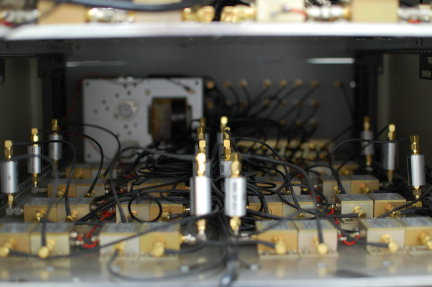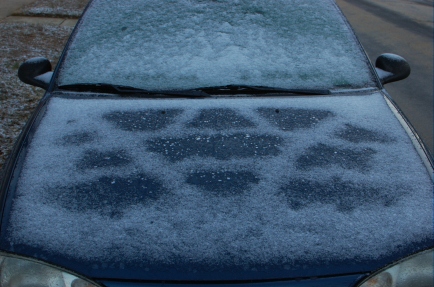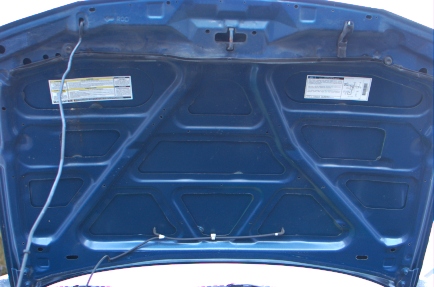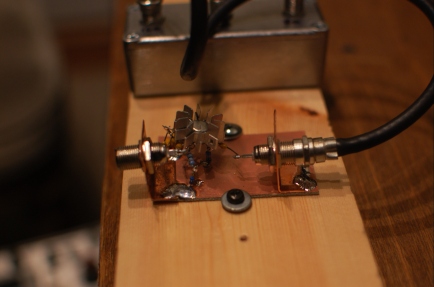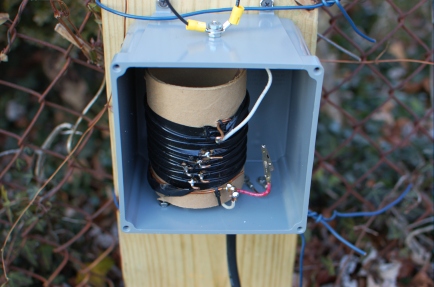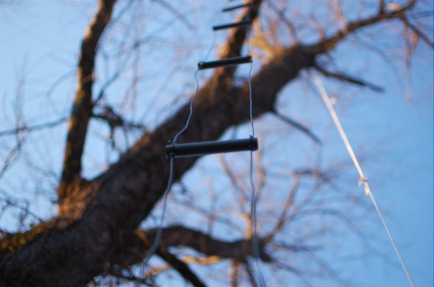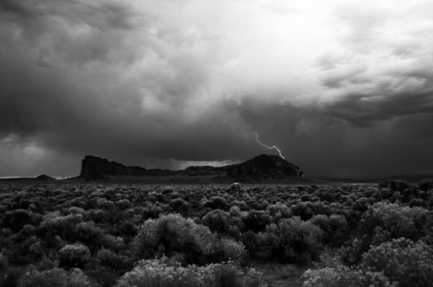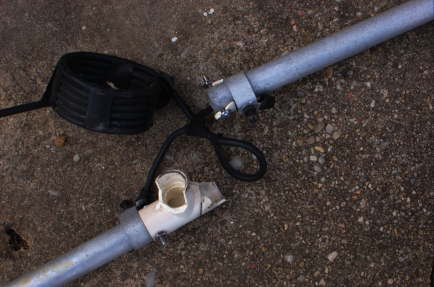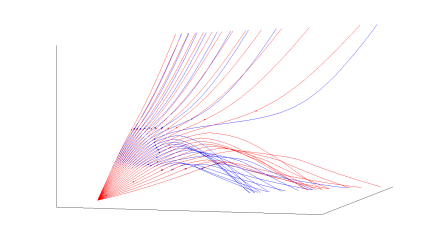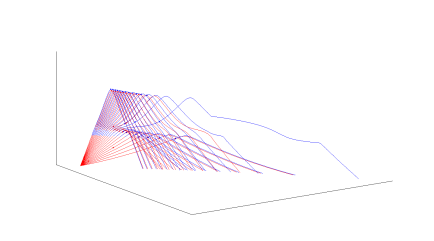A few photographs from work on the Wallops Island SuperDARN radar last week…
Archive for the ‘engineering’ category
Wallops Island SuperDARN
February 21st, 2011NA Sprints, ARRL DX, and other notes
February 21st, 2011February, like November, is a busy month for contesting: the CW edition of the NA Sprint leads off the month (along with the Minnesota QSO Party), followed by the phone edition of the NA Sprint the second weekend, and of course, the ARRL DX CW contest on the third weekend.
In short…
NA Sprint CW SO-LP: claimed 162 x 38 = 6156, preliminary 158 x 38 = 6004. Four busted QSOs is actually better than I felt at the end. So, that is good. Still not happy with the numbers, though.
NA Sprint Phone SO-LP: claimed 28 x 16 = 448 in 1 hour operating time. As KE3X told me, his NS score was higher that week! The phone Sprint is more fun from a bigger station, but really suffers from lack of participation.
ARRL DX SOAB-LP: claimed 544 x 243 = 396,576 in 14 hours. This should have been a bit better, but I got sucked into trying to make myself heard in EU on 160 before their sunrise. Killed almost 60 minutes on 15 QSOs there. Also only operated about 1-2 hours during prime EU time on each of Sat/Sun morning. Efforts at getting a run started were a complete failure. Need. More. Firepower. I was very pleased to work ZM1A on 10 meters, though.
Other notes…
After 17ish years of amateur radio, I finally installed my first 30-meter antenna—a dipole at 35ish feet. First QSO was ST2AR, so I guess it’s working alright.
A box full of goodies arrived from Down East Microwave this week and I started working on buttoning up the 1296-MHz W1GHZ transverter. Massive thanks to Ben, N3UM, who lives nearby for sharing his construction notes with me. Not too far along other than punching and tapping a few holes in a diecast box. The DEMI box also included a couple of LNA boards that I hope to tune up for 432.
High winds (90 km/h gusts, according the forecast) from Friday night through Saturday night did not manage to topple my FO12 and A50-3S from their perch on the chimney. I haven’t checked the rotator to see if they still turn, though. This antenna situation needs to change eventually.
Finally, I also managed to score about 250 feet of RG-213 and 10 feet of LMR-600 from a dumpster-diving excursion. The LMR will make nice jumpers from the 903 and 1296 transverters to their respective antennas and I can use the RG-213 to replace the RG-8X on some of my HF antennas.
Ice on the hood
January 21st, 2011W7IUV preamplifier
January 20th, 2011An evening project: W7IUV low-band receive preamplifier. Total cost: < $10. Total time: 1 hour.
It worked pretty well on 80 and 160 with the crossed K9AYs. The 48-volt relays in the box at the antennas are sticking (thanks to using a 40-volt PSU). I need to rebuild this with lower-voltage relays or a higher-voltage power supply.
W7IUV claims that he just leaves his connected to his RX port all the time. But, he probably has more spacing between his TX and RX antennas than I do. It will be interesting to see if I get enough RF coupled from my TX antennas to destroy the transistor.
Recent tinkerings (9 Jan 2011 edition)
January 9th, 2011Several people have commented over the years that I should “write more” on the blog. I usually respond that I could spend my free time tinkering/hamming or blogging, but not both. Here are a month’s worth of blog posts as freestyle poetry:
- A section on my workshop has been added to k8gu.com under Engineering.
- Discovered that although the SoftRock VHF Ensemble II won’t fit (barely) into the Bud CU-473 diecast box I bought for it, it will fit into an extruded enclosure that housed an ancient X-band radar detector I picked up at Dayton in 2002 in hopes of stripping the Gunn diode assembly and getting on 10 GHz. Bonus points for thriftiness. Photos will follow once I finish the project.
- Did not observe Quadrantid meteor pings with the SoftRock VHF Ensemble II, but did notice something interesting about the W3APL beacon. Need to investigate.
- Have more CE/K8GU QSL cards again, finally. Tonight, I might finish the bureau (and, ashamedly one direct) cards languishing. Some K8GU (and AA8UP, no kidding) bureau cards are sitting here staring at me, too. Not a big project, though.
- Operated the NAQP CW on Saturday (8 January 2011) for four hours and twenty minutes and made 318 QSOs x 128 multipliers for 40,740 points before log-checking discounts. This total is pleasing to me especially considering that it was almost all leap-frogging SO2R search-and-pounce, which can be very fatiguing. It’s fun to see the rate meter stay over 100 when you’re S&Ping. Good Sprint practice.
- Still the best 30 minutes on the radio every week: I operated the NS Ladder on Thursday (6 January) night and made my customary 30 QSOs x 24 multipliers for 720 points. Hopefully, adding 160 will give me some momentum to increase this score back over 1000.
- We had a spell of 50F (10C) weather on New Years’ Eve. So, I put the 2-meter beam back up on the chimney. It was formerly mounted on a steel mast that was ratchet-strapped to the chimney. A strong wind (>50 mph gusts) before Christmas bent the mast (actually a fence top-rail) and I had removed it. I cut the bent lower portion of the mast off and attached the remaining top portion with rotator to a “girder” constructed from two pieces of treated 2″ x 4″ x 10′ lumber joined with a half-dozen lag screws. Again, I ratchet-strapped the entire assembly to the chimney. The present configuration is much stronger and less prone to damage. The 3-element 50-MHz Yagi is still on the ground until I actually get the transverter finished, which should be soon (as it has been for 12 months now).
- Repaired a SoftRock v6.2 downconverter for WF1L and learned that you can solder leads back onto SOIC packages if you’re careful.
- Have had delightful exchanges with KN6X and ZL1CDP about repairing the TS-930S. Some of these discussions (and their fruits) may make it onto the site at some point.
- Back in December, I started integrating the W1GHZ transverters using UT-141 semirigid jumpers with pre-installed SMA connectors obtained on attractive terms from Max-Gain Systems. Mitsubishi RA18H1213G (1296 MHz) and RA30H0608M (50 MHz) modules arrived from RF Parts. May have a lead on something less expensive with more gain for 903 MHz via HA1AG. The big remaining tasks in all three transverter projects are the sequencer and IF interfacing.
- Also in December, I had dinner with NS Ladder father Bill, N6ZFO, in San Francisco at the Hyde Street Seafood House & Raw Bar, which is a favorite of NA Sprint father, Rusty, W6OAT. Yes, I did feel that I was in the presence of greatness. (I had their excellent pork chops since I’m not into seafood, especially raw seafood.) Like most contesters, Bill’s a super, fascinating guy apart from his radio contesting interests.
A short vertical for 160 meters
January 9th, 2011160 meters, Topband, …the names conjure all sorts of visions of grandeur, enigmatic propagation modes, and big antennas in the minds of hams everywhere. Since I have lived on suburban lots for the past five and a half years and in an apartment for two years before that, it has been the better part of a decade since I’ve had my own permanent 160-meter antenna system at my “home” station. (Despite this, I did manage to get 160-meter WAS from NO9Z’s station and if my Rhode Island and Delaware contacts ever upload to LoTW, I’ll request the certificate from ARRL.)
So, the story at hand. Just before the November Sweepstakes contest, I put up a secondary 80-meter antenna—the open-wire fed dipole I used at K8GU/9. Its performance was underwhelming and the vertical seemed to play just fine. But, I got busy and just left it up in the trees. Somewhere in the annals of the Blog, I may or may not have described this antenna, which was designed to also operate on 160 by shorting the feeder and feeding the whole mess against ground. I never used this functionality because I had to lay radials on top of the patio and that was a pain to take them up and put them down.
The North American QSO Party was this weekend and I’ve been participating in the NCCC Sprint Ladder, both of which include 160 meters. Around about last Thursday, after the NS Ladder, I decided it might be fun to have 160 for the NSL and NAQP. So, I ducked out of the office early on Friday afternoon and set about stripping the old tuning network from the K8GU/9 incarnation of the antenna.
We have a lot of AM broadcast stations in the DC area. And, because of that, antenna analyzers are not always too useful on the low bands. So, knowing already that the antenna was near self-resonance after my K8GU/9 efforts, the first thing I did was just hook the antenna up to a TS-930 and give it a 5-10 watts fed against my nearby 80-meter vertical’s radial field. Sure enough, the VSWR was about 3 at 1.999 MHz and off-scale at 1.801 MHz. So, I inserted the loading coil from the old matching box. The coil is just #14 THHN solid wire in approximately the optimum-Q configuration of diameter to length and wound on a cardboard shipping tube. (As is clear from the photograph, it’s not really pretty nor the lowest-loss possible. But, it was great for what I had on-hand.)
The coil has four taps on it. I clipped the fourth tap, shorting the bottom half of the inductor and did the VSWR sweep, finding a dip at 1.950 MHz or so. Each successive tap brought the minimum lower and lower. With no taps clipped, it was tuned to the bottom of the band. I got lucky (erm, did a lot of tweaking at the previous QTH).
The best news of all of this is that there is enough RF actually being radiated (not just as heat, either!) to make some contacts! Further good news is that even though the antenna is between three and five feet from my 80-meter vertical, with the W3NQN filters, I can operate SO2R on both bands simultaneously. Of course, the RX noise level may just be hiding the trash. I haven’t tried the K9AY because I had that portion of the station torn-up during the conversion of all my DC accessories to PowerPoles and the preamp popped a fuse in my RigRunner when I plugged it back in.
The bottom line is that it’s not a full-sized 4-square, but it gets me on 160 from my lot in a way that’s compatible with my operating style.
“Electricity is NOT a toy”
January 2nd, 2011The ARRL 10-meter (28-MHz) contest was a couple of weeks ago. Given that I had bothered to install a 10-meter antenna at this QTH and that conditions seem to be improving, I thought it would be fun to play.
I fired up CQing on Saturday and after a few minutes, Sarah appeared at the shack doorway. This usually means that something is broken or I’m causing RFI to something she wants to be using. Since I’m not KT0R, who used to tell his neighbors that he was “busy and please come back on Monday,” I obliged her. It was the CO detector again. I unplugged it (it’s battery-backed, so it just means that contesting burns through 9-volt batteries) and returned to the game. Peace reigned again in the Miller household.
Sneaking in a little bit of contesting before church on Sunday morning is a long-standing habit of mine, although it seems that the Sunday openings are usually better than the Saturday openings. Today was no exception. I was working hard to extract a few QSOs out of what appeared to be a mostly dead band and Sarah again showed up at the shack doorway—this time with wet hair and quite agitated.
“The outlet is popping when I plug the hair-dryer into it!”
I assured her that I would take care of it, adding that it was “probably just the radio getting into the GFI. Let me send a few dits and see if it starts clicking.”
“No, you stay there, I’ll send the dits. How do you do it?”
“Just press the left paddle.”
And so, Sarah made her first ham radio transmission on 10-meter CW this morning (after which I did identify, for the record). I confirmed that the outlet made a little click. She was not completely convinced, but I told her I would shut down while she dried her hair so I could monitor the situation.
The hairdryer (a prior unit), Sarah, and I have had run-ins before. Several years ago, when we were poor graduate students, a loose screw was causing a nasty vibration in the old hairdryer. So, I tightened it up and gave it back to her, not knowing that there was another screw floating around inside the case. One morning, that screw found its way into the motor and sparked. When Sarah called me on the phone, I thought she’d burnt the house down. As much as it pains me, I no longer attempt to fix any appliances that cost less than $50 as a result of this episode.
Still worked up, Sarah took the opportunity to grill me about the compatibility of contesting with family life…”When have children, how will you hear them if they’re in trouble and you have your headphones on? (In jest, I later proposed wiring a baby monitor into the SOnR audio chain.) Can’t you listen with the speaker? How will we keep them from eating your little parts, bits of wire, and globs of solder? Electricity is not a toy!”
We laughed at the last one. And she added, “I hope they’re all girls who want everything hot pink—so much hot pink that we want to barf.”
I suppose if someone makes a hot-pink Hello Kitty AK-47 (the photo actually looks like a painting of an AR-15) and the Sarah-cuda bow, we can find hot-pink solder irons, paddle finger pieces, headphones, and even radios (I seem to recall that there was a BabyPhat mod’ed hot-pink Motorola HT floating around the web a few years ago).
Anyhow, this post is for Sarah because she puts up with a lot of tinkering, RFI, and headphone time and gets very little blog recognition in return for it.
(The photo above is of Ft Rock, Oregon, taken by me when I was on assignment there.)
One-step dipole pruning
January 2nd, 2011Dad and I built a 10-meter rotable dipole some 12-13 years ago using pieces of a large Wilson tribander that I had begged off of a local ham. It was an interesting mechanical design, using a 3/4-inch CPVC tee fitting as the center insulator and mounting bracket. The third leg of the tee slipped over a piece of EMT conduit that we had crimped. The EMT, in turn telescoped into a RadioShack-type TV mast, which was bracketed to our deck. It was a fun antenna back when 10 meters was fun.
That CPVC tee lasted a good deal longer in the UV and wind than we ever imagined. Granted, the antenna was stored in my folks’ garage for 7-8 years while I was in college and graduate school. But, I reinstalled it when we moved to Maryland. Last week brought high winds to the Mid-Atlantic region and the fitting gave up the ghost:
Fortunately, it takes all of a half-hour and another 33-cent fitting to replace it. I did think of running a piece of pipe, dowel, or fiberglass across the element for extra strength. But, I’ll do that if it fails again soon. The process of repairing the antenna reminded me of the technique we used to tune it, which we thought was very clever at the time.
We used the “magic” 468 to set the initial length of the antenna optimized for 28.400 MHz, which was totally wrong since 468 is intended for bare wire, not tapered aluminum. Then, we installed it and measured the VSWR across the band (in the shack). Next, we took the frequency of the minimum VSWR and divided that by the design frequency. Then, took the antenna down and scaled the length of the antenna by the quotient from the previous step. Finally, we reinstalled the antenna and measured the VSWR across the band. It hit dead-on. Dad was impressed that my first two QSOs were KL7 and ZS! It was, of course, ten meters when ten meters was good.
This may be old-hat to a lot of folks, but we thought we were geniuses at the time, although it was purely an act of shade-tree engineering! For those who don’t mind watching sausage made, I will now muse on the validity of the technique.
Suppose you have a “magic factor,” M (=468 or whatever), that defines the frequency of minimum VSWR for an antenna of length l:
 Rearranging that will be useful later:
Rearranging that will be useful later:
If we take the partial derivative of each side in the first equation, and substitute M from the second equation we get the following relationship:
Cross-multiplying/-dividing and abusing the partial derivative notation to be a small perturbation yields:
 This is subtly different from the original technique, which can be derived from this using some small-number approximations. But, the point is that there exists a simple technique to prune a dipole to resonance. delta-f is the offset between the design and actual VSWR minimum frequencies, f is the design VSWR minimum, l is the design length, delta-l is the amount that needs to be added (pruned).
This is subtly different from the original technique, which can be derived from this using some small-number approximations. But, the point is that there exists a simple technique to prune a dipole to resonance. delta-f is the offset between the design and actual VSWR minimum frequencies, f is the design VSWR minimum, l is the design length, delta-l is the amount that needs to be added (pruned).
W1GHZ 1296 MHz RX working!
November 19th, 2010I spent about two hours last night assembling the W1GHZ 1296RSU and 1152LO boards from his paper “Multiband Microwave Transverters for the Rover—Simple and Cheap.” Once again, I trekked over to W3APL beacon site at lunch and put the pair through their paces on RX with the IC-290H as the IF radio. It worked! Here’s a clip:
One of the interesting things about the 1296-MHz beacon is that it’s FSK, not CW. You’ll notice this after about 15 seconds when it starts sending its callsign. The higher pitch tone is “keyed” and the lower is “unkeyed.” Brian, ND3F, was at the beacon site with us last week to check out a problem (turned out to be a dead power supply fan). He told us that it’s common for microwave beacons to operate in FSK mode so you always have a carrier to tune across (and swing your antenna across). Who knew?!
Anyhow, it’s time to start building the other trappings, including enclosures, sequencers, filters, PAs, and T/R switches! Apart from the PA parts and some connectors, the other components are on-hand and ready.
Raytracing
November 19th, 2010Today we have a little bit of fun ham-related tinkering from work. This is two different frequencies transmitted from the same site.
There are lots of neat details in a ray-trace: skip focusing, Pedersen rays, mode-splitting, … One thing that’s fun about writing your own models is that you can modify (intentionally or not) the model physics to do unphysical things…
The second run shows X and O modes for a single frequency and a failed attempt at modeling an MF signal into an E-F region duct. (The ducting, by the way, has nothing to do with my actual work. I was simulating it for ham purposes, although it helped me uncover a problem.) The signals do get to the duct, but they bend the wrong way. This has been fixed in the code, but it serves to remind that modelers have complete control. The background ionosphere is relatively unphysical in this one as well…
The raytrace code used above is small, simple, and written in MATLAB. I doubt that it will ever be released publicly, but if so I will note it here on the blog.


